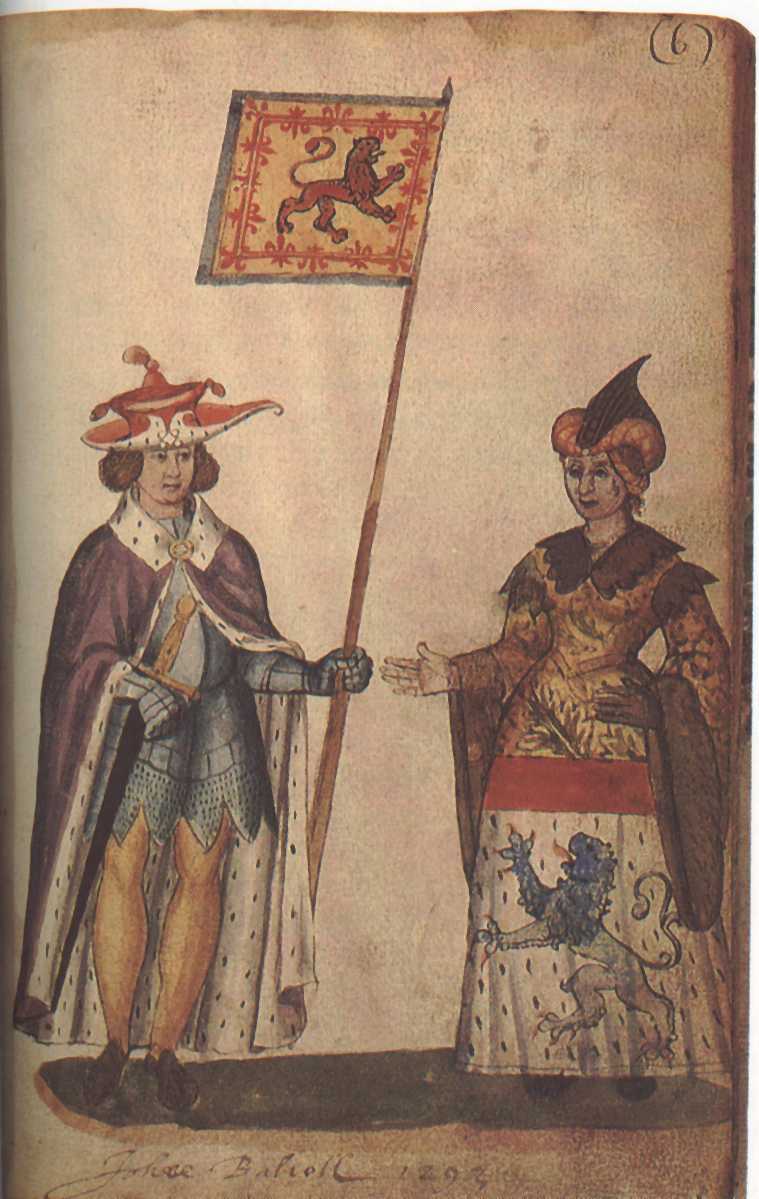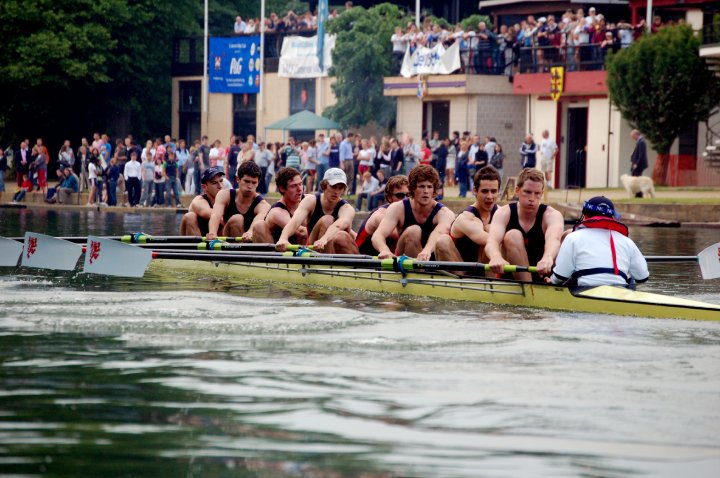|
John, King Of Scots
John Balliol or John de Balliol ( – late 1314), known derisively as Toom Tabard (meaning 'empty coat'), was King of Scots from 1292 to 1296. Little is known of his early life. After the death of Margaret, Maid of Norway, Scotland entered an interregnum during which several competitors for the Crown of Scotland put forward claims. Balliol was chosen from among them as the new King of Scotland by a group of selected noblemen headed by King Edward I of England. Edward used his influence over the process to subjugate Scotland and undermined Balliol's personal reign by treating Scotland as a vassal of England. Edward's influence in Scottish affairs tainted Balliol's reign, and the Scottish nobility deposed him and appointed a council of twelve to rule instead. This council signed a treaty with France known as the "Auld Alliance". In retaliation, Edward invaded Scotland, starting the Wars of Scottish Independence. After a Scottish defeat in 1296, Balliol abdicated and was impriso ... [...More Info...] [...Related Items...] OR: [Wikipedia] [Google] [Baidu] |
List Of Scottish Monarchs
The monarch of Scotland was the head of state of the Kingdom of Scotland. According to tradition, Kenneth I MacAlpin () was the founder and first King of the Kingdom of Scotland (although he never held the title historically, being King of the Picts instead). The List of kings of the Picts, Kingdom of the Picts just became known as the Kingdom of Alba in Scottish Gaelic, which later became known in Scots language, Scots and English as ''Scotland''; the terms are retained in both languages to this day. By the late 11th century at the very latest, Scottish kings were using the term , or King of Scots, to refer to themselves in Latin. The Kingdom of Scotland was merged with the Kingdom of England to form a single Kingdom of Great Britain in 1707. Thus, Anne, Queen of Great Britain, Queen Anne became the last monarch of the ancient kingdoms of Scotland and England and the first of Great Britain, although the kingdoms had shared a monarch since 1603 (see Union of the Crowns). Her un ... [...More Info...] [...Related Items...] OR: [Wikipedia] [Google] [Baidu] |
Balliol Arms
Balliol may refer to: * House of Balliol, Lords of Baliol and their fief * Balliol College, Oxford ** Balliol rhyme, a doggerel verse form with a distinctive meter, associated with Balliol College * John Balliol (King John of Scotland) (1249–1314) ** John I de Balliol (1210–1269), his father ** Edward Balliol Edward Balliol or Edward de Balliol (; – January 1364) was a claimant to the Scottish throne during the Second War of Scottish Independence. With English help, he ruled parts of the kingdom from 1332 to 1356. Early life Edward was the el ... ( 1283–1364), his son, King of Scots * Roussel de Bailleul (died 1077), Norman adventurer * Boulton Paul Balliol, a British two-seat training aircraft {{disambiguation, surname ... [...More Info...] [...Related Items...] OR: [Wikipedia] [Google] [Baidu] |
David, Earl Of Huntingdon
David of Scotland (1152 – 17 June 1219) was a Scottish prince and Earl of Huntingdon. He was the grandson of David I and the younger brother of two Scottish kings, Malcolm the Maiden and William the Lion. Life Born in 1152, David was the youngest surviving son of Henry of Scotland, 3rd Earl of Huntingdon and Ada de Warenne, a daughter of William de Warenne, 2nd Earl of Surrey, and Elizabeth of Vermandois. His paternal grandfather was David I of Scotland. Huntingdon was granted to him after his elder brother William I of Scotland ascended the throne. David's son John succeeded him to the earldom. In 1190 his brother gave him 'superiority' over Dundee and its port. The same year he endowed Lindores Abbey in Fife and a church dedicated to St Mary in Dundee. In the litigation for succession to the crown of Scotland in 1290–1292, the great-great-grandson Floris V, Count of Holland of David's sister, Ada, claimed that David had renounced his hereditary rights to th ... [...More Info...] [...Related Items...] OR: [Wikipedia] [Google] [Baidu] |
Alan, Lord Of Galloway
Alan of Galloway (before 1199 – 1234) was a leading thirteenth-century Scottish magnate. As the hereditary Lord of Galloway and Constable of Scotland, he was one of the most influential men in the Kingdom of Scotland and Irish Sea zone. Alan first appears in courtly circles in about 1200, about the time he inherited his father's possessions and offices. After he secured his mother's inheritance almost two decades later, Alan became one of the most powerful magnates in the Scottish realm. Alan also held lands in the Kingdom of England, and was an advisor of John, King of England concerning Magna Carta. Alan later played a considerable part in Alexander II, King of Scotland's northern English ambitions during the violent aftermath of John's rejection of Magna Carta. Alan participated in the English colonisation of Ulster, receiving a massive grant in the region from the English king, and simultaneously aided the Scottish crown against rebel claimants in the western and norther ... [...More Info...] [...Related Items...] OR: [Wikipedia] [Google] [Baidu] |
Balliol College
Balliol College () is a constituent college of the University of Oxford. Founded in 1263 by nobleman John I de Balliol, it has a claim to be the oldest college in Oxford and the English-speaking world. With a governing body of a master and around 80 fellows, the college's main buildings are located on Broad Street with additional buildings to the east in Jowett Walk and Holywell Manor. As one of the larger colleges of Oxford University, Balliol typically has around 400 of both undergraduates and graduates. The college pioneered the PPE degree in the 1920s. Balliol has notable alumni from a wide range of disciplines. These include 13 Nobel Prize winners and four British prime ministers. History and governance Foundation and origins Balliol College was founded in about 1263 by John I de Balliol under the guidance of Walter of Kirkham, the Bishop of Durham. According to legend, the founder had abducted the bishop as part of a land dispute and as a penance he was publicly b ... [...More Info...] [...Related Items...] OR: [Wikipedia] [Google] [Baidu] |
John, 5th Baron Balliol
John de Balliol (before 1208 – 25 October 1268) was an English nobleman, belonging to the House of Balliol. Balliol College, in Oxford, is named after him. Life John de Balliol was born before 1208 to Cecily de Fontaines, daughter of Aléaume de Fontaines, chevalier, seigneur of Fontaines and Longpré-les-Corps-Saints and Hugh de Balliol, Lord of Balliol and of Barnard Castle and Gainford ( 1177 – 2 February 1229). It is believed that he was educated at Durham School in the city of Durham. In 1223, Lord John married Dervorguilla of Galloway, the daughter of Alan, Lord of Galloway and Margaret of Huntingdon. By the mid-thirteenth century, his wife had become very wealthy, principally as a result of inheritances from her family. This wealth allowed Balliol to play a prominent public role, and, on King Henry III's instruction, he served as joint protector of the young king of Scots, Alexander III. He was one of Henry III's leading counsellors between 1258 and 1265. and ... [...More Info...] [...Related Items...] OR: [Wikipedia] [Google] [Baidu] |
County Durham
County Durham, officially simply Durham, is a ceremonial county in North East England.UK General Acts 1997 c. 23Lieutenancies Act 1997 Schedule 1(3). From legislation.gov.uk, retrieved 6 April 2022. The county borders Northumberland and Tyne and Wear to the north, the North Sea to the east, North Yorkshire to the south, and Cumbria to the west. The largest settlement is Darlington. The county has an area of and a population of . The latter is concentrated in the east; the south-east is part of the Teesside urban area, which extends into North Yorkshire. After Darlington, the largest settlements are Hartlepool, Stockton-on-Tees, and Durham, England, Durham. For Local government in England, local government purposes the county consists of the Unitary authorities of England, unitary authority areas of County Durham (district), County Durham, Borough of Darlington, Darlington, Borough of Hartlepool, Hartlepool, and part of Borough of Stockton-on-Tees, Stockton-on-Tees. Durham Count ... [...More Info...] [...Related Items...] OR: [Wikipedia] [Google] [Baidu] |
Barnard Castle
Barnard Castle (, ) is a market town on the north bank of the River Tees, in County Durham, England. The town is named after and built around a medieval castle ruin. The town's Bowes Museum has an 18th-century Silver Swan automaton exhibit and paintings by Goya and El Greco. Barnard Castle is on the left bank of the River Tees, opposite to Startforth, and is south-west of the county town of Durham. Nearby towns include Bishop Auckland to the north-east, Darlington to the east and Richmond to the south-east. The largest employer is GlaxoSmithKline, with a manufacturing facility on the town's outskirts. History Before the Norman Conquest, in 1066, the upper half of Teesdale was combined into an Anglo-Norse estate, which was centred upon the ancient village of Gainford, and mortgaged to the Earls of Northumberland. During Norman times, in 1080, the first Norman Bishop of Durham, Bishop Walcher, was murdered. This led to the surrounding country being attacked and ... [...More Info...] [...Related Items...] OR: [Wikipedia] [Google] [Baidu] |
Picardy
Picardy (; Picard language, Picard and , , ) is a historical and cultural territory and a former regions of France, administrative region located in northern France. The first mentions of this province date back to the Middle Ages: it gained its first official recognition in the 13th century through the nation of Picardy at the University of Paris and entered French administration in the 14th century. Unlike regions such as Normandy, Brittany, or Champagne (province), Champagne, Picardy was never established as a duchy, county, or principality, and its boundaries fluctuated over the centuries due to the political instability in the area it covered. Since 1 January 2016, it has been part of the new region of Hauts-de-France. The first geographic description of Picardy appeared in the late central Middle Ages, including the bishoprics of Amiens, Beauvais, Arras, Tournai, and Thérouanne. In the late Middle Ages, it also encompassed Saint-Quentin, Douai, Abbeville, Béthune, Clermo ... [...More Info...] [...Related Items...] OR: [Wikipedia] [Google] [Baidu] |
Galloway
Galloway ( ; ; ) is a region in southwestern Scotland comprising the counties of Scotland, historic counties of Wigtownshire and Kirkcudbrightshire. It is administered as part of the council areas of Scotland, council area of Dumfries and Galloway. Galloway is bounded by sea to the west and south, the Galloway Hills to the north, and the River Nith to the east; the border between Kirkcudbrightshire and Wigtownshire is marked by the River Cree. The definition has, however, fluctuated greatly in size over history. A native or inhabitant of Galloway is called a Gallovidian. The region takes its name from the ''Gall-Gàidheil'', or "stranger Gaels", Norse–Gaels, a people of mixed Gaelic and Norse descent who seem to have settled here in the 10th century. Galloway remained a Gàidhealtachd area for much longer than other regions of the Scottish Lowlands and a Galwegian Gaelic, distinct local dialect of the Scottish Gaelic language survived into at least the 18th century. A hardy ... [...More Info...] [...Related Items...] OR: [Wikipedia] [Google] [Baidu] |
Tabard
A tabard is a type of short coat that was commonly worn by men during the late Middle Ages and early modern period in Europe. Generally worn outdoors, the coat was either sleeveless or had short sleeves or shoulder pieces. In its more developed form it was open at the sides, and it could be worn with or without a belt. Though most were ordinary garments, often work clothes, tabards might be emblazoned on the front and back with a heraldry, coat of arms (livery), and in this form they survive as the distinctive garment of Officer of Arms, officers of arms. In modern British English, British usage, the term has been revived for what is known in American English as a Apron#Tabard, cobbler apron: a lightweight open-sided upper overgarment, of similar design to its medieval and heraldic counterpart, worn in particular by workers in the catering, cleaning and healthcare industries as Personal protective equipment, protective clothing, or outdoors by those requiring high-visibility clot ... [...More Info...] [...Related Items...] OR: [Wikipedia] [Google] [Baidu] |
Coat Of Arms
A coat of arms is a heraldry, heraldic communication design, visual design on an escutcheon (heraldry), escutcheon (i.e., shield), surcoat, or tabard (the last two being outer garments), originating in Europe. The coat of arms on an escutcheon forms the central element of the full achievement (heraldry), heraldic achievement, which in its whole consists of a shield, supporters, a crest (heraldry), crest, and a motto. A coat of arms is traditionally unique to the armiger (e.g. an individual person, family, state, organization, school or corporation). The term "coat of arms" itself, describing in modern times just the heraldic design, originates from the description of the entire medieval chainmail "surcoat" garment used in combat or preparation for the latter. Roll of arms, Rolls of arms are collections of many coats of arms, and since the early Modern Age centuries, they have been a source of information for public showing and tracing the membership of a nobility, noble family, a ... [...More Info...] [...Related Items...] OR: [Wikipedia] [Google] [Baidu] |






